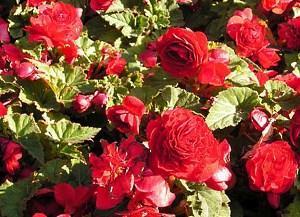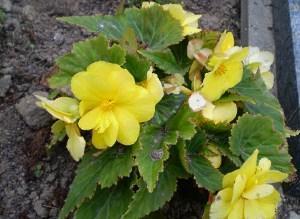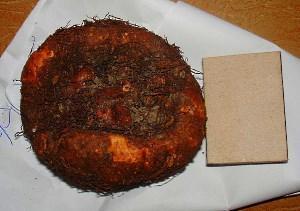How to organize the correct wintering of begonias
 Begonia will delight and delight in the luxury of its flowering for more than one year, if you take responsibility for its storage in the offseason and ensure proper care of the flower in winter.
Begonia will delight and delight in the luxury of its flowering for more than one year, if you take responsibility for its storage in the offseason and ensure proper care of the flower in winter.
Types of begonias
Before talking about how to preserve begonias in winter, let's start with the fact that there are several types of begonias:
- decorative deciduous;
- bushy;
- tuberous.

Bushy and decorative deciduous species do not need special wintering conditions. To prevent them from dying in winter, it is enough to cut off wilted stems when cold weather sets in and mulch the bushes with straw or garden leaves.
The most demanding care and maintenance in the winter tuberous begonias.
The beauty and duration of flowering of this magnificent flower directly depends on how to care for begonia in winter.
If begonia does not bloom for a long time, or it has small and few flowers, this suggests that it was stored incorrectly in winter.
Caring for soil-grown begonia
 Adult plants have fairly large tubers. If they grew in open ground, then, trying not to damage them, they are dug up at the onset of the first frost.
Adult plants have fairly large tubers. If they grew in open ground, then, trying not to damage them, they are dug up at the onset of the first frost.
However, you should not rush to dig up the plant, since autumn frosts do not damage the tubers.
You need to wait until the flower independently prepares for wintering - that is, the vegetative part will die off, the leaves turn yellow and fall off.
In addition, at the end of the growing season, the tubers noticeably increase in size, increase their mass, since when the aerial part dies off, all nutrients leave them. At the same time, renewal buds are laid, from which new shoots will develop after overwintering the begonia.
Having dug up, you need to cut off the frozen stems, leaving shoots (hemp) no more than 3 cm high on the surface. This procedure prevents the formation of pathogenic fungi that contribute to the infection of tubers.
 Then they clean the plant of soil, put it in a box and place it to dry in a well-ventilated, warm, dry room. Two weeks later, when the roots are dry, the dried out shoots and the remaining soil are removed.
Then they clean the plant of soil, put it in a box and place it to dry in a well-ventilated, warm, dry room. Two weeks later, when the roots are dry, the dried out shoots and the remaining soil are removed.
Next, the tubers are placed in wooden boxes in several rows and sprinkled with river sand or dry peat with the addition of vermiculite.
The addition of vermiculite is highly desirable because, due to its ability to regulate the moisture content of the substrate, the risk of root rot is significantly reduced.
Important: sprinkle the tubers with a sand mixture so that they are isolated from each other - this will reduce the percentage of their loss.
The begonias prepared for wintering are placed in a cool place, where the temperature should not exceed 10 ° C, humidity of about 60% - these are usually basements and cellars.
The plant remains in a dormant period for almost three months - from mid-November to almost the end of February, during all this time it is impossible to water, otherwise dormant buds wake up.
Periodically, but at least once a month, the condition of the tuber is examined for the presence of mold and root rot.
When a lesion is found, it is cleaned and treated with colloidal sulfur or brilliant green. If the lesion is extensive, then the plant is removed to prevent the spread of the infection.
In early spring, in March, when dormant flower buds begin to awaken on the tubers, they are removed from the sand and placed for germination in a moist substrate prepared on the basis of peat with the addition of high-quality humus and river sand, taken in the same volume.
Containers with germinated tubers are set closer to the light, watering is limited, the temperature of the content is about 18 ° C.
Tubers germinate rather slowly and unevenly. First of all, they put down roots. Sprouts that appear later should be shaded from the sun and ventilated more often, but no drafts should be allowed.
This time is well suited for dividing tubers, their reproduction. The cut is processed with colloidal sulfur in powder or crushed charcoal.
Many people manage to successfully preserve begonia in winter in boxes with a lump of earth on the loggia, if it does not freeze, or in the coolest places in the apartment - at the balcony or front door.
How to keep young begonia tubers in winter
All of these actions are good for healthy and robust tubers. In the event that they are very small and flabby, you will have to act differently.
The fact is that the behavior of a young plant and an adult flower is significantly different, therefore, tubers of different sizes during the dormant period are stored in different ways.
- Small nodules-first-year of the flower in winter must be kept in a cool place and be sure to water it periodically, otherwise the root system may dry out.
The dormant period of first-year girls is rather arbitrary, since their shoots do not fall off during the winter period, although growth stops. - Having dug out such a nodule, it is placed in a plastic bag filled with dry peat and placed in a household refrigerator. Begonia is examined periodically. In case of premature emergence of sprouts, they must be broken out, since they are not viable.
- Young begonias can be left to winter in boxes set in a cool, bright place, watered moderately. With the onset of spring, they are seated in separate pots with a substrate.
They are transplanted into the ground when a stable positive temperature occurs.
Winter care for home begonia
Begonia, grown in pots in summer, blooms until late autumn. With the onset of cold weather, she plunges into a state of rest. At this time, it is not recommended to transplant begonia, but it is imperative to reduce watering. Watering should be done only when the soil in the pot becomes completely dry, because excess moisture can cause root rot.
With the beginning of the heating season, the air in the apartment becomes very dry, so you need to spray the air near the flower every day using a spray bottle.
As you can see, it is not difficult to care for begonias in winter, you just need to show a little attention to it, the answer to which will be an abundantly and brightly blooming garden.